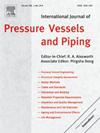Research on the expansion and failure of solid expandable tubular based on the Johnson-Cook failure model
IF 3
2区 工程技术
Q2 ENGINEERING, MECHANICAL
International Journal of Pressure Vessels and Piping
Pub Date : 2025-05-27
DOI:10.1016/j.ijpvp.2025.105567
引用次数: 0
Abstract
The exploration and development of deep unconventional oil and gas wells pose new challenges to the solid expandable tubular (SET) technology. Determining the expansion limit of the SET is of great significance for reducing costs, improving design efficiency and ensuring construction safety. Therefore, a new method for studying and predicting the expansion limit of the SET is proposed. Based on the Johnson-Cook constitutive model and failure model, combined with the expansion test of the SET and the material tensile test, a numerical simulation of the expansion failure behavior of the SET were conducted. The influence of sensitive parameters such as expansion speed, pipe material, ovality, wall thickness, and wall thickness unevenness on the limit expansion rate of SET were systematically analyzed. The research results show that: 1) Either too fast or too slow an expansion speed will reduce the expansion limit of SET. The recommended expansion speed for 20G is 1 m/s 2) The limit expansion ratios of 20G, 316L, and Al (2024) pipe materials are 27 %, 51 %, and 22.5 % respectively. 3) For every 1 % increase in the ovality of the pipe, the limit expansion rate of the SET decreases by approximately 0.26 %. For every 1 mm increase in the wall thickness of the pipe, the limit expansion rate of the SET increases by approximately 0.65 %. For every 1 % increase in the wall thickness unevenness of the pipe, the limit expansion rate of the SET decreases by approximately 2.91 %. The results can provide theoretical guidance for the design and construction of the SET.
基于Johnson-Cook破坏模型的固体膨胀管膨胀破坏研究
非常规深层油气井的勘探开发对固体膨胀管(SET)技术提出了新的挑战。确定SET的扩展极限对降低成本、提高设计效率、保证施工安全具有重要意义。因此,本文提出了一种研究和预测SET扩展极限的新方法。基于Johnson-Cook本构模型和破坏模型,结合SET的膨胀试验和材料拉伸试验,对SET的膨胀破坏行为进行了数值模拟。系统分析了膨胀速度、管材、椭圆度、壁厚、壁厚不均匀度等敏感参数对SET极限膨胀率的影响。研究结果表明:1)膨胀速度过快或过慢都会降低SET的膨胀极限。2) 20G、316L、Al(2024)管材的极限膨胀率分别为27%、51%、22.5%。3)管道椭圆度每增加1%,SET的极限膨胀率降低约0.26%。管壁厚度每增加1mm, SET的极限膨胀率增加约0.65%。管道壁厚不均匀度每增加1%,SET的极限膨胀率降低约2.91%。研究结果可为SET的设计和施工提供理论指导。
本文章由计算机程序翻译,如有差异,请以英文原文为准。
求助全文
约1分钟内获得全文
求助全文
来源期刊
CiteScore
5.30
自引率
13.30%
发文量
208
审稿时长
17 months
期刊介绍:
Pressure vessel engineering technology is of importance in many branches of industry. This journal publishes the latest research results and related information on all its associated aspects, with particular emphasis on the structural integrity assessment, maintenance and life extension of pressurised process engineering plants.
The anticipated coverage of the International Journal of Pressure Vessels and Piping ranges from simple mass-produced pressure vessels to large custom-built vessels and tanks. Pressure vessels technology is a developing field, and contributions on the following topics will therefore be welcome:
• Pressure vessel engineering
• Structural integrity assessment
• Design methods
• Codes and standards
• Fabrication and welding
• Materials properties requirements
• Inspection and quality management
• Maintenance and life extension
• Ageing and environmental effects
• Life management
Of particular importance are papers covering aspects of significant practical application which could lead to major improvements in economy, reliability and useful life. While most accepted papers represent the results of original applied research, critical reviews of topical interest by world-leading experts will also appear from time to time.
International Journal of Pressure Vessels and Piping is indispensable reading for engineering professionals involved in the energy, petrochemicals, process plant, transport, aerospace and related industries; for manufacturers of pressure vessels and ancillary equipment; and for academics pursuing research in these areas.

 求助内容:
求助内容: 应助结果提醒方式:
应助结果提醒方式:


